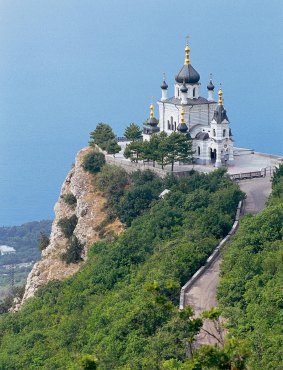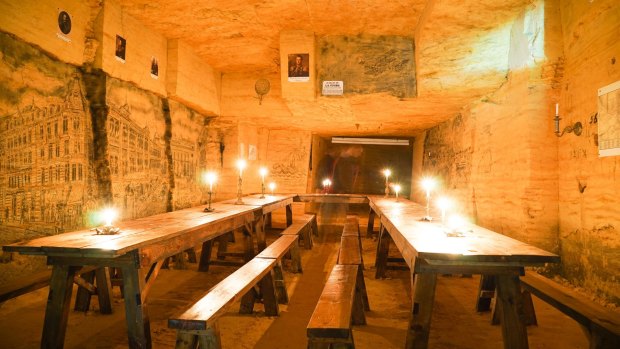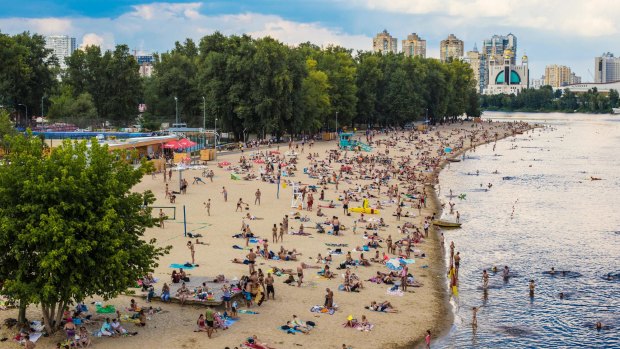This was published 5 years ago
Cruising Ukraine: A spectacular but little-visited European country

Foros church in Yalta, Crimea.Credit: Viking Cruises
The catacombs of Odessa are haunted by the ghosts of explorers and smugglers who lost their way in the tangled web of tunnels that undergird the city. But the soul of this Black Sea port isn't confined to these subterranean cavities, says my guide Tanya Solovyova. No, it lives above, in the courtyards of the Ukrainian baroque and art nouveau buildings that line the city's cobblestone streets.
Balconies face each other over these central meeting places, Solovyova says, "so that you can always speak to your neighbour in the morning".
Such geniality has animated Odessa in the centuries since it was established on the ruins of a Greek settlement at the behest of Catherine the Great in 1794. People flocked here from all over Europe and the east: the French, Turks, Tatars and Jews; refugees, serfs and traders. By 1910, the population had reached half a million.

Inside the Odessa catacombs.Credit: Shutterstock
The catacombs, created by miners quarrying limestone to use in the construction of Odessa, are a city unto themselves and the world's longest network of tunnels (about 2500 kilometres) that, over the centuries, have served noble and nefarious purposes.
"The first tenants were criminals and the homeless," Solovyova says. "They created little cities underground."
Later came the partisans, transforming the catacombs into bunkers, schoolrooms and hospitals during World War II, when Odessa was occupied by the Nazis. After liberation, the network was used to smuggle goods – and people – to and from ships anchored in the Black Sea.

Venice beach in Kiev is popular with locals and tourists.Credit: Shutterstock
I imagine these smugglers popping out from exits scattered along the coastline as we set sail from Odessa on the Viking Sineus. While their suppliers were trading goods from Istanbul and the world beyond the Bosphorus, we are venturing inland, up the Dnieper River that burrows into the Ukrainian heartland and flows all the way north to Belarus.
This is similar to the route taken in reverse by Catherine the Great as she and her lover, Prince Grigory Potemkin, sought to expand the Russian Empire. They pair are immortalised all the way from here to Kiev in the statues and monuments, palaces and cathedrals erected in their honour.
Perhaps most poignant is St Catherine's Cathedral in the delta city of Kherson, where Potemkin is buried in an unremarkable grave. Inside, the mood is solemn; locals cross themselves and light candles. But outside the sun blasts down from a cloudless sky and hibiscus and rose gardens frame the sandstone basilica.
This is ordinarily a sun-bleached, colour-drained landscape, Solovyova says, but recent rains have transformed the parks into oases. Overgrown and somewhat forlorn, the newly greened spaces are vivified by the brightly dressed women – yellow-and-white polka dots, pink-and-blue stripes – strolling as though they're extras in a movie. Down at the waterfront, a gang of boys somersault from the wharf into the shimmering river, like subjects in an Impressionist painting.
From here, the river arcs eastwards through steppes and plateaus dotted with the polished domes of Eastern Orthodox churches, modest pitch-roofed farmhouses and red Ukrainian cows (bred from red German cows and now-extinct Ukrainian bulls, fiery creatures that weigh up to two tonnes each).
This landscape's bounty fills my plate at mealtimes: tomatoes so sweet you can eat them like apples; beetroot that turns borscht into puddles of crimson; varenyhiki (dumplings) stuffed with creamy-white cheese.
The river climbs through fertile farmlands towards Zaporozhye, then passes through a lock into the Dnieper Hydroelectric Dam, the largest project of its kind when it was completed in 1932. This city is well-known for its Cossack history, but few are aware of the tragedy that befell it during World War II: in order to slow the Nazis' advance, the Red Army bombed the dam wall, causing a flood so enormous it engulfed the river's shorelines and drowned tens of thousands of people.
"We say this dam was constructed on the bones of our citizens," Solovyova, a resident of Zaporozhye, says.
The effects of World War II linger upriver, too, in Dnipro, where around 11,000 Jews – mostly women and children – were imprisoned inside a requisitioned building before being shot. Today, the 1930s structure functions as a shopping centre and a memorial plaque remembers the lives that it once cradled.
The most recent hostility to disrupt Ukraine's peace – the ongoing conflict with Russian-backed separatists in Crimea, Luhansk and Donetsk, which lies just 230 kilometres east of here – is memorialised at an open-air exhibition off one of the city's park-lined streets. The wrecked body of an ambulance is overlaid with a latticework sculpture; the shot-up signs bearing the names of affected villages are lined up in a solemn procession.
A harvest ceasefire has been declared, but skirmishes occur each day. But there's no sign of discord or tragedy as we continue northwards along the river towards Kremenchug, an important town on the trading route between the 16th-century duchy of Muscovy (Moscow) and the Black Sea, and onwards towards Ukraine's capital, Kiev.
The farmland bordering the Dnieper is quilted in sunflowers, their faces turned skywards to track the sun. The river enlarges from a brook into a lake, its edges fringed with wetlands and secret beaches where locals spear umbrellas into the shore, and two-man tinnies float like lily pads, their bare-chested skippers idly drinking beer and checking their fishing rods, all the while bronzing their torsos.
It's fitting that I'm eating red caviar and sipping Ukrainian sparkling wine ("as good as the very best," says our host) as we cruise into Kiev. The river is slick with yachts and pleasure boats now, the beaches spread out languorous along the shoreline, pale bodies bobbing like corks in the shallows.
Champagne flute in hand, I behold a bright, polished city spreading upwards from the left bank as though gathered into a decorative ruche. Soaring above its ramparts is the Soviet-era Motherland Monument, her sword held aloft piercing the sky, and the domes of Kiev's Monastery of the Caves, glowing in beatific counterpoint to the statue's Communist stridency.
TRIP NOTES
Catherine Marshall travelled as a guest of Viking Cruises.
MORE
FLY
Emirates flies to Dubai several times daily. Connect to Odessa and Kiev with FlyDubai or via Warsaw with Emirates and LOT Polish Airlines. See emirates.com.au, flydubai.com/en and lot.com/pl/en
CRUISE
Viking Cruises' 2019 departures from Odessa to Kiev start from $5195 per person . See vikingcruises.com.au
VISAS
The Ukrainian government has recently implemented an e-visa application process. See australia.mfa.gov.ua/en/consular-affairs/services/Visa+to+Ukraine
SAFETY
The Australian government advises against all travel to Crimea, Donetsk and Luhansk. These areas are not included on Viking Cruises' Ukraine itinerary. See smarttraveller.gov.au
Sign up for the Traveller Deals newsletter
Get exclusive travel deals delivered straight to your inbox. Sign up now.